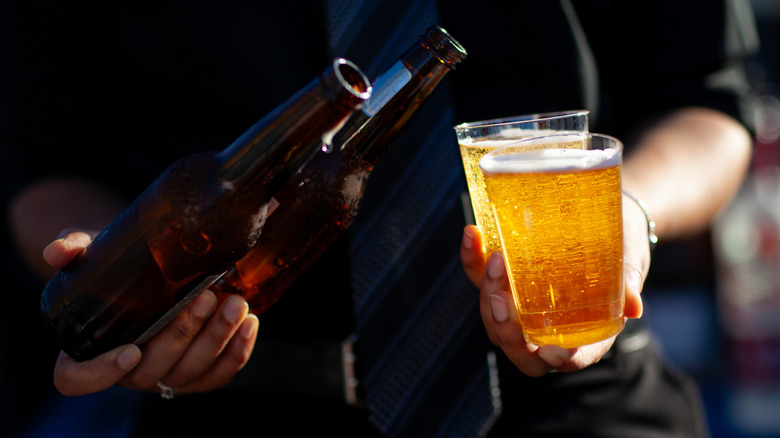What's That Stuff At The Bottom Of Your Beer Bottle And Is It Safe To Drink?
Sip on a nice beer from one of the best breweries in the U.S., and it's easy to forget the complex processes that lead to its creation. There's an intricate art to selecting ingredients and refining procedures for successful fermentation. Brewers work hard to make beers complex yet drinkable, letting drinkers partake without distraction.
However, every once in a while, there's a reminder that the process derives from nature. Perhaps you've noticed this evidence in the form of sediment in your bottle. Appearing as a suspended white haze at the bottom, you may wonder if the compound impacts the drinking experience. To put it succinctly, no need to worry; This substance is dead yeast, and it's totally safe to drink. In fact, it likely doesn't even impact the flavor.
This yeast arises in unfiltered beer styles like IPAs and hefeweizens. It's a result of interactions between yeast particles and protein that then descend to the bottom of the bottle. Often, brewers filter out this sediment, but this maneuver also turns beers clear. So these particles are kept in certain styles, thereby resulting in a richer brew.
Beer sediment is made of dead yeast
There are two techniques that most prominently contribute to the creation of sediment. First, there's bottle conditioning. In order to create carbonation, brewers add sugar or unfermented beer to already-bottled beer. As a result, the beer undergoes more fermentation, thereby creating gas and perpetuating freshness. Leaving the dead yeast in the mix is a more natural process, carried out during the creation of historic beverages like cloudy Viking beer.
Conversely, purposefully hazy beers utilize the yeast-protein mixture after bottling. This move enhances the thick mouthfeel and can add a delicate spice to the flavor. This is used more often in hefeweizens where, once poured, the yeast is redistributed throughout the beer. Alternatively, if you're not keen on seeing any sediment, you can always leave it in the bottom of the bottle. Just like you might be wondering how much beer foam is ok, know that beer sediment won't impact your enjoyment; It simply alters the appearance of your brew.

